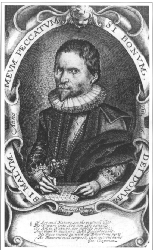




Portrait sometimes said to be of Thomas Harriot in 1620,
British Museum engraving by Francis Delaram.
Reproduced from Staiger, R.C., Thomas Harriot, Science Pioneer,
New York: Clarion Books, 1998.
(Other sources make this a portrait of the Scottish mathematician
John Napier (1550-1617); to be sorted out...).
Born in 1560, Harriot spend his life under the patronage of wealthy nobles, first by Lord Walter Raleigh upon graduating from Oxford, and then starting in 1593 by Henry Percy, Earl of Northumberland.
Harriot kept regular correspondence with other scientists and mathematicians, especially in England but also in mainland Europe, notably with Kepler. For unknown reasons, Harriot refrained from publishing most of his scientific work, with the exception of his observations as scientist to Lord Raleigh's 1585 expedition to the New World, published in 1588. He however left many notebooks of scientific observations, which were only uncovered much later in the late eighteenth century, and not properly studied for another 100 years thereafter.
Harriot's early telescopic observations rival those of Galileo and contemporaries. Starting in July 1609 he observed the moon regularly, apparently for the purpose of determining the distance of the Sun using Aristarchus's method, as evidenced by the numerous drawings of the Moon at first and third quarter later found in his notebooks
On the basis of surviving historical documents, it appears that Harriot was the first to observe sunspots, as evidenced by entries in his notebook dated 8 December 1610. (Following the priority dispute with Scheiner, Galileo claimed that he had been observing sunspots since the summer of 1610, but no direct written evidence has been found to support this claim). However, Harriot subsequently failed to pay much attention to sunspots until a year later. After reading Galileo's Sidereus Nuncius he also observed the satellites of Jupiter, but as with sunspots Harriot failed to grasp (or at least make note of) the physical significance of his observations.
Throughout his life Harriot pursued extremely original research on the refraction of light, binary mathematics, ballistics, spherical geometry, cyphers and codes, and algebra. He is now credited with independent discovery of the sine law of refraction, first published by René Descartes but earlier discovered, again independently, by Wilbrod Snell. His accurate observations of the 1607 comet were used much later, in 1784, by Friedrich Wilhelm Bessel to compute the comet's orbital elements, which led to the realization that the 1607 comet was in fact Halley's comet. Harriot died on July first 1621 in London.
Chapman, A. 1995, Q. J. R. Astr. Soc., 36, 97-107
Herr, R.B. 1978, Science, 202, 1079-1081
Shirley, J.W. 1982, Thomas Harriot: a biography, Oxford: Oxford University Press
 To search for a Solar Physicist
To search for a Solar Physicist
![]() To references and further reading
To references and further reading
last modification on january 18 2008 by
paulchar@astro.umontreal.ca
Tous droits réservés / Copyrighted by
Université de Montréal